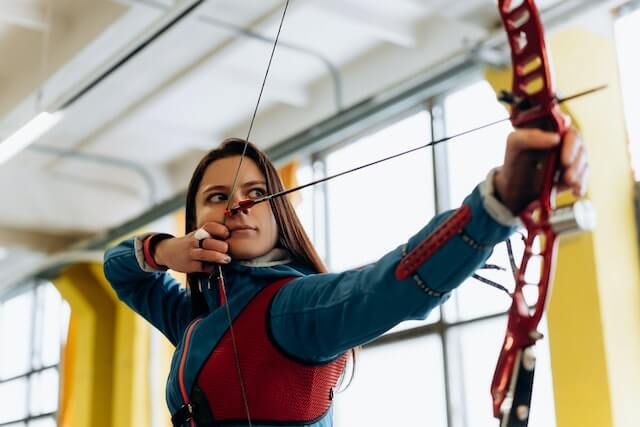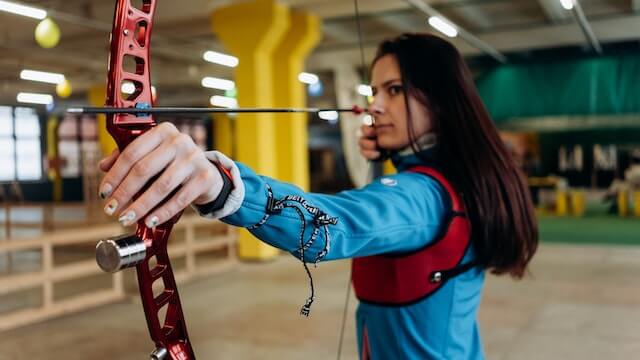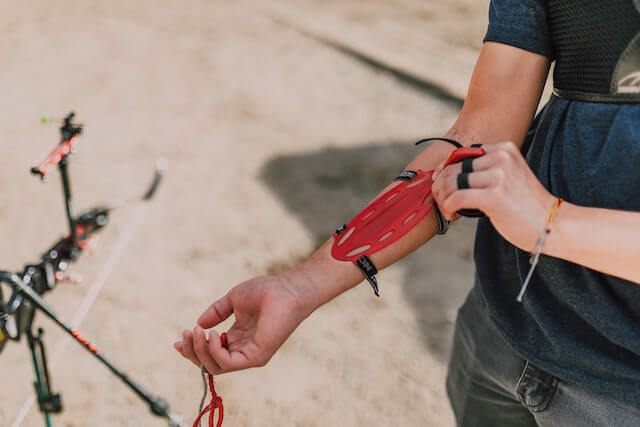There are few things in archery that beginners worry about more than the thought of a bowstring slap into the forearm. It’s enough to put some people off from even picking up the bow!
That excruciating sting can easily be avoided with some simple technique tweaks. Ones that are not often mentioned, but if ignored, can lead to you taking away a nice little purple souvenir from your archery experience.
Form a V-shape with your thumb and forefinger, then place the fleshy part between your thumb and forefinger against the grip. Wrap your forefinger and thumb loosely around the grip with your fingers turned out at about 45 degrees. Gripping the riser this way means that your elbow naturally rotates out of the path of the string.
A student’s first reaction to a string slap might be ‘What am I doing wrong?’. But there are several different causes of bowstring slap. In this article, we’ll look at the top 7 common causes and what you can do to fix them.
7 Common Causes Of Bowstring Slap and How To Fix Them
1. Incorrect Bow Grip
As we mentioned above, gripping the bow incorrectly changes the positioning of your forearm. If you have all your fingers wrapped tightly around the riser, it tends to straighten out your wrist, making it much more likely that the string will hit it.
Target archers generally keep their fingers off the riser to keep their arm correctly aligned. If they aren’t wearing a sling, then the forefinger and thumb gently wrap around the riser to keep the bow in place.
2. Incorrect Elbow Rotation
It can be difficult to understand what ‘rotate your elbow’ actually means. A lot of people will try to move their elbow from their shoulder, which can cause their entire posture to change.
Adopting the V-grip helps to place your wrist, forearm and elbow in a more natural position.
3. Fatigue
This is related to the fact that the longer you shoot, the more tired you become, and therefore the easier it is for your form to break down.
And there’s nothing like a bowstring slap to bring that to your attention!
Make sure you’re taking regular breaks if you’re shooting for long periods to avoid any lapses in concentration.

4. A Closed Stance
If you stand perpendicular to the target, you’ll find that your bow arm is much closer to the string. From the anchor point, the line of pull is directly across the chest and down the forearm. This is great for aiming, but not so great for avoiding string slap.
Opening your stance up a little not only creates a much more stable base but increases the space in which the string can pass without hitting your forearm.
5. Weak Muscles
Drawing a bow back involves the bigger muscles of the upper back, but if you simply don’t have enough development then you will likely compensate by leaning your body back and lifting your shoulder.
If this is happening, then you’ll likely hit your arm with the string every time.
It’s crucial to shoot from the correct position, otherwise, you will most certainly develop injuries over time.
The correct stance should put the weight of the bow onto your skeletal structure, so you don’t have to rely on your muscles too much.
6. The Wrong Draw Weight
This leads to the next point. Draw Weight.
A draw weight that is too heavy can highlight those weaker muscles and bad posture in no time. It’s quite common when you’re trying to perform a movement pattern that your body is just not used to.
Try to spend some time doing exercises that specifically target the upper back and rear shoulders to help you handle the bow better.
7. Incorrect Brace Height
Another common area for bowstring slap is the area just below the wrist joint. More often than not, this is caused by having the wrong brace height.
The brace height is the distance between the bowstring and the neck of the riser.
If your brace height is set too low then this will bring the string much closer to the wrist. The string will continue to move forward and snap back to its original position after release which can impact the wrist.
Make sure that you check the manufacturer’s guidelines for brace height for your bow. You can alter the brace height by removing or adding twists to the bowstring or by adjusting the tiller bolts.
What Is The Bowstring Slap In Archery?
The string slap in archery occurs when the string travels forwards upon release and connects with the skin of the inner arm, elbow or wrist of the archer.
This can cause pain, bruising, lacerations and severe blows to the ego.
Fortunately, it’s never really serious and it will heal after a few days just like any bruise. The bruises on your arm, not necessarily your ego.
And it’s not just beginners who experience the sting of the string. Professional archers often pay for a lapse in concentration with a sharp string slap.
Best Way To Avoid The Bow String Slap In Archery
Among instructors, the favoured culprit of the string slap is the position of the elbow. If you’re hitting your inner forearm or wrist with a string, then you need to rotate your elbow back. While this may seem a relatively easy fix, it’s not as easy as it may seem.
And it’s definitely not the only reason why you are catching the string.
The fact is, that your body is a series of links in a chain. If there is a problem with one link, the source of that problem can usually be found further up, or down the chain.
Think about your bow arm as if it were 3 links in a chain:
- Wrist
- Elbow
- Shoulder

If you have a problem with your elbow, the centre link, it stands to reason that the cause of the problem and the solution could be located in a different part of the chain.
Your wrist is the anchor linking your arm, and therefore your body to the bow. How you hold the bow, is going to determine how the rest of the chain acts in relation to it.
Get A Grip
If you’ve been holding and squeezing the bow in a death grip, you’re more than likely over-extending your bow arm so the string striking your forearm is much more likely.
Instead, you should try adopting the V-grip.
- Extend your bow arm forward and form a V shape with your thumb and forefinger.
- Place the fleshy pad between your thumb and forefinger against the bow grip
- Grip the bow loosely with your thumb and forefinger only
- Your other 3 fingers should be at a 45-degree angle and off the riser
Do You Have To Wear An Arm Guard?
There are two ways to look at this.
There are archers who say that they prefer not to wear an arm guard because repeatedly hitting your arm with the string will force you to correct your mistakes.

In the other camp, archers say that wearing an armguard is not about stopping string slap, but about mitigating the effects on the arrow if the string does come into contact with your forearm.
This is the reason that modern Olympic archers still wear arm guards. because they want to preserve the speed of the arrow, and these are the best shooters in the world!
Historical Longbow archers are famous for wearing a leather bracer on their forearms. Can you imagine what being hit by a 150lb Warbow string felt like?!
Not wearing an armguard doesn’t necessarily mean that you’re a better archer. As a beginner, however, you probably should wear one. After all, an armguard is a piece of safety equipment, just until you get that grip and elbow rotation sorted out!
Conclusion
The string slap is not a rare thing, and many experienced, as well as professional archers all experience it at some point.
There are many causes that can easily be fixed if you have the inclination and the patience. Wearing an armguard as a beginner can help to boost your confidence, but as soon as you have the fundamentals dialled in, including your grip and elbow rotation, feel free to drop the arm guard.
Be safe knowing that your technique is on point enough so that your forearm doesn’t end up looking like raw tenderloin!

0 Comments